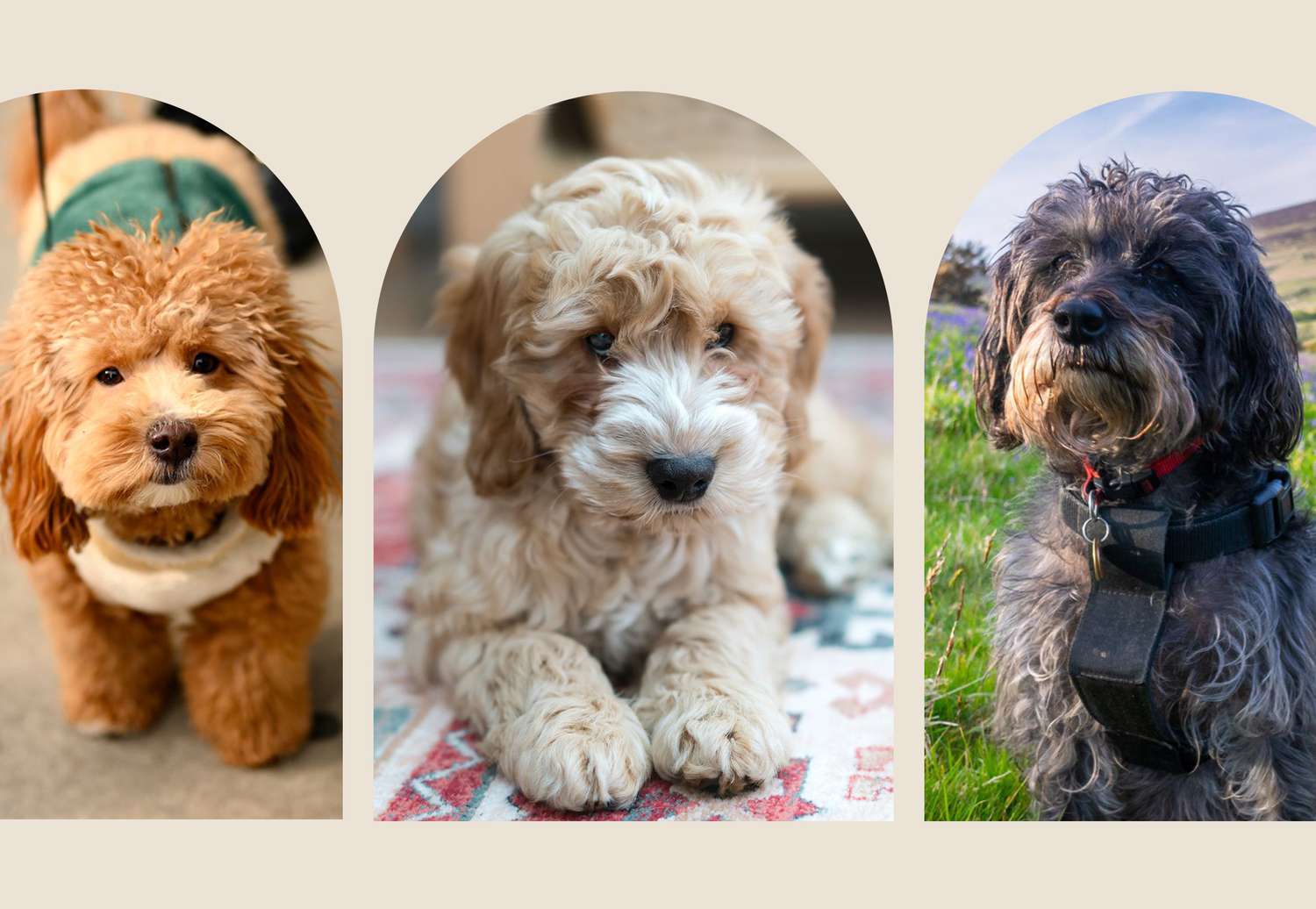Article-at-a-Glance
-
Discover the joys and considerations of owning hypoallergenic dog mixes like Schnoodles, Cockapoos, and Maltipoos.
-
Learn how to select the right hypoallergenic dog mix for your lifestyle and living space.
-
Explore essential accessories designed for the unique needs of hypoallergenic dog breeds.
-
Understand the importance of health screenings and regular check-ups for mixed breed dogs.
-
Get practical tips for training, socialization, and ensuring the well-being of your new furry family member.

“A Guide to Poodle Mixes and Doodle Dogs” from www.marthastewart.com and used with no modifications.
Welcome to the World of Hypoallergenic Pooches
Embracing a dog into your life is a journey filled with affection, laughter, and sometimes, a bit of sneezing. For those with allergies, the quest for a hypoallergenic friend can be a bit more challenging. Enter the world of hypoallergenic dog mixes, where breeds like Schnoodles, Cockapoos, and Maltipoos reign supreme. These breeds are crafted with love and care to bring the joy of pet ownership to more homes, without the worry of allergic reactions.
Celebrating the Schnoodle: A True Friend with Benefits
The Schnoodle, a spirited mix between a Schnauzer and a Poodle, boasts the best of both worlds: intelligence and a hypoallergenic coat. These bundles of energy are known for their agility and friendly demeanor, making them excellent companions for active individuals or families. Their low-shedding fur is a blessing for allergy sufferers, but remember, no dog is 100% hypoallergenic. Regular grooming is key to maintaining a healthy coat and minimizing potential allergens.
Cockapoos: Cuddly Companions that Keep Your Tissues at Bay
Cockapoos, the adorable cross between Cocker Spaniels and Poodles, are the epitome of a loving lapdog with a twist of hypoallergenic charm. Their wavy coats are less likely to trigger allergies, although they do require consistent grooming to stay clean and tangle-free. These dogs are sociable and adaptable, fitting perfectly into various households, whether it’s a bustling family home or a quiet apartment.
Because of the low to non-shedding nature of the Maltipoo, they are considered Hypoallergenic and a great option for those with allergies. – My Doodle Puppy
Maltipoos: The Ultimate Companions for Allergy Sufferers
On the smaller side of the hypoallergenic mixes, we have the Maltipoo, a delightful crossbreed of the Maltese and Poodle. These dogs are not only charming and affectionate but also come with a coat that’s friendly to those with allergies. Their adaptable nature makes them suitable for a variety of living situations, and they thrive on companionship. However, like all hypoallergenic breeds, they do best with regular grooming to keep their fluffy coats in top condition.
Choosing the Best Fit: Guidance on Hypoallergenic Dog Mixes
Now that you’re familiar with some of the most popular hypoallergenic dog mixes, let’s delve into how to choose the right one for you. It’s not just about the cuteness overload; it’s about finding a dog that matches your lifestyle, energy levels, and living situation.
Selecting Your New Best Friend: Understanding Dog Temperaments
Every dog is unique, but breed mixes can inherit a variety of traits from their parent breeds. When considering a hypoallergenic mix, it’s important to research the temperament of both parent breeds. For example, a Schnoodle may inherit the Poodle’s intelligence and the Schnauzer’s boldness. Understanding these traits can help you prepare for a pet that’s both mentally stimulating and assertive.
Match Made in Heaven: Size Considerations for Your Living Space
Space is a premium, especially in urban environments. When choosing a hypoallergenic dog mix, consider the size of the dog in relation to your living space. A smaller Maltipoo may be more comfortable in an apartment, while a larger Schnoodle might need more room to stretch their legs. Always keep in mind the exercise needs of your chosen breed to ensure a happy, healthy pet.
Exercise Requirements: Keeping Your Mix Breed Happy and Healthy
Exercise is vital for all dogs, and hypoallergenic mixes are no exception. These dogs often inherit the high energy levels of their parent breeds, requiring regular physical and mental stimulation. A Cockapoo might love a game of fetch just as much as a leisurely walk, while a Schnoodle could excel in dog sports like agility. Ensuring adequate exercise will keep your dog fit and prevent behavior issues stemming from boredom.
Finding the Perfect Harness for Sensitive Skin
When it comes to accessorizing your hypoallergenic dog, the right harness is about more than just fashion—it’s about comfort and health. Dogs with sensitive skin need a harness that won’t irritate or cause allergic reactions. Look for harnesses made from breathable materials like cotton or mesh, and avoid those with rough edges or heavy metal components that can rub and chafe. Always check the fit; a harness that’s too tight can lead to discomfort, while one that’s too loose can cause chafing from excessive movement.
Beds and Blankets: Comfort for Your Non-Shedding Companion
After a long day of play, your hypoallergenic pooch deserves a cozy spot to rest. Choose beds and blankets that cater to their non-shedding coat. Materials like fleece or microfiber not only provide warmth and comfort but also minimize the amount of dander that sticks to the fabric. This can help keep allergens at bay. Washable beds and blankets are a must, as regular cleaning will maintain a fresh environment for both you and your pet.
The Importance of Choosing Right Toys for Your Pooch
Playtime is essential for every dog’s development and happiness, but for hypoallergenic breeds, the choice of toys can also affect their health. Opt for toys that are free of materials known to cause allergies, such as latex or certain dyes. Also, because these dogs often have a strong bite, look for durable toys that won’t break apart easily, reducing the risk of ingestion and potential allergic reactions.
Ensuring a Healthy Future: Health Screenings for Your Dog
Adopting a hypoallergenic dog mix is just the beginning. To ensure they lead a long and happy life, regular health screenings are essential. These checks can help catch any potential issues early, especially since some conditions may be inherited from their parent breeds. Be proactive in scheduling visits to the vet and keep an eye out for any unusual signs in your dog’s behavior or appearance. Consider exploring dog water rehab as a part of their health routine.
Why Regular Check-Ups are Crucial for Mix Breeds
Mix breeds like Schnoodles, Cockapoos, and Maltipoos can inherit health issues from both sides of their lineage. This makes regular veterinary check-ups a critical component of their care. During these visits, vets can monitor for signs of common conditions such as hip dysplasia, luxating patellas, or eye disorders. Early detection often means a better prognosis and a happier, healthier dog.
The Role of Genetics: Common Health Concerns in Mixes
Understanding the genetic predispositions of your hypoallergenic dog mix is key to their wellbeing. For instance, Cockapoos can be prone to ear infections due to their floppy ears, while Poodle mixes may be at risk for skin conditions. Regular grooming and attentive care can mitigate these risks. Educate yourself on the common health concerns associated with your dog’s specific mix to stay ahead of potential issues.
Finding the Right Veterinarian for Designer Breeds
Not all veterinarians are created equal when it comes to understanding the nuances of designer dog breeds. Seek out a vet who has experience with hypoallergenic mixes and is knowledgeable about their specific needs. They should be well-versed in the potential genetic issues and able to provide tailored advice for your dog’s care and maintenance. Building a relationship with the right vet can make all the difference in your pet’s health.
Mixing it Right: Tips for Future Owners Frequently Asked Questions
As you embark on the journey of bringing a hypoallergenic dog mix into your life, it’s natural to have questions. These breeds are not just adorable; they come with their own set of needs and considerations. Let’s tackle some of the most frequently asked questions to help you get started on the right paw.
-
What makes a dog breed ‘hypoallergenic’? It’s the dog’s ability to produce fewer allergens, not a complete absence of them. Breeds with non-shedding coats, like Poodles, are often a good choice for allergy sufferers.
-
How often should I groom my designer dog? Depending on the breed, grooming may be required every 4-8 weeks, with regular brushing in between.
-
Can designer dogs be good with kids? Absolutely, but like all dogs, they require proper socialization and training to ensure they are well-behaved with children.
-
What are the most common health issues in poo mixes? This varies by breed, but can include hip dysplasia, ear infections, and eye problems.
-
How can I ensure I’m adopting a healthy designer dog? Research reputable breeders, ask for health clearances, and consider adopting from a rescue that provides veterinary assessments.
Understanding the Commitment: What Owning a Mix Breed Entails
Owning a hypoallergenic dog mix is a long-term commitment that should not be taken lightly. These dogs require love, attention, and care just like any other breed. Ensure you’re ready for the responsibility of daily walks, regular grooming, and ongoing training. Remember, the joy of having a furry friend comes with the duty of providing them with the best life possible.
Top Considerations Before Bringing a Hypoallergenic Dog Home
Before you decide to bring a hypoallergenic dog into your home, consider the lifestyle changes you’ll need to make. These dogs often require more grooming than non-hypoallergenic breeds, and they may have specific dietary needs. You’ll also need to be prepared for regular vet visits to manage any inherited health conditions. Most importantly, ensure that everyone in your household is ready for the commitment of caring for a dog.
Training and Socialization: Setting Up for Success
Training and socialization are crucial for any dog, but especially so for designer breeds like Schnoodles, Cockapoos, and Maltipoos. These dogs can be intelligent and eager to please, making them relatively easy to train. Socialization helps prevent behavioral issues and ensures your dog is well-adjusted and confident. Start training early, and use positive reinforcement methods to encourage good behavior.
Frequently Asked Questions
When it comes to hypoallergenic dog mixes, potential owners have many questions. From grooming needs to health concerns, it’s important to gather as much information as possible before making the decision to bring one of these special breeds into your life.
What Makes a Dog Breed ‘Hypoallergenic’?
The term ‘hypoallergenic’ is a bit of a misnomer when it comes to dogs. No dog is completely free of allergens, but hypoallergenic breeds produce fewer allergens than others. These breeds typically have hair that grows continuously, like human hair, which means less shedding and dander. Poodles and their mixes are often considered hypoallergenic due to their non-shedding coats.
It’s important to note that individual reactions to dog allergens can vary greatly. Some people may still experience allergies with hypoallergenic breeds, so it’s wise to spend time with the breed you’re considering before bringing one home.
Additionally, hypoallergenic dogs still produce saliva and urine, which can also contain allergens. Regular bathing and grooming can help minimize these allergens in your environment.
-
Non-shedding coats are typical of hypoallergenic breeds, leading to fewer allergens in the home.
-
Individuals may react differently to various breeds, so personal exposure before adoption is recommended.
-
Saliva and urine are also sources of allergens; maintaining cleanliness is key.
How Often Should I Groom My Designer Dog?
Designer dogs with hypoallergenic coats, such as Schnoodles, Cockapoos, and Maltipoos, typically require regular grooming. This can range from every 4 to 8 weeks, depending on the breed and the individual dog’s coat. Daily brushing is also recommended to prevent matting and to keep the coat clean and free of debris.
Grooming isn’t just about keeping your dog looking good—it’s essential for their health. A well-groomed coat allows for better skin breathing and can prevent skin infections. Always use the right grooming tools and seek professional grooming services if you’re unsure how to properly care for your dog’s coat.
Can Designer Dogs be Good with Kids?
Designer dogs can be excellent companions for children when properly trained and socialized. It’s important to teach both the dog and the children how to interact with each other respectfully. Supervision is key, especially with younger children, to ensure safe and positive interactions. Breeds like Maltipoos are known for their gentle and friendly nature, making them a popular choice for families.
What Are the Most Common Health Issues in Poo Mixes?
While hypoallergenic dog mixes like Schnoodles, Cockapoos, and Maltipoos are generally healthy, they can inherit health issues from their parent breeds. Some common concerns include:
-
Hip dysplasia, particularly in larger mixes
-
Ear infections, due to floppy ears that can trap moisture
-
Eye problems, such as cataracts or progressive retinal atrophy
-
Skin conditions, especially in dogs with folds or wrinkles
Regular vet check-ups and a healthy lifestyle can help manage these issues. Always ask the breeder about the health history of the parent breeds and any screenings they’ve done on the puppies.
Because of the low to non-shedding nature of the Maltipoo, they are considered hypoallergenic and a great option for those with allergies. – My Doodle Puppy
How Can I Ensure I’m Adopting a Healthy Designer Dog?
To ensure you’re adopting a healthy designer dog, research reputable breeders who conduct health screenings and genetic testing on their breeding dogs. Ask for health clearances and meet the puppy’s parents if possible. A good breeder will be transparent about the health of their dogs and the potential for inherited conditions.
-
Research breeders thoroughly and ask for health certifications.
-
Meet the puppy’s parents to observe their health and temperament.
-
Consider adopting from a rescue that provides veterinary assessments.
-
Invest in pet insurance to cover unexpected health issues.
Remember, adopting a dog is a lifelong commitment. By taking the time to find a healthy, well-suited companion, you’re setting the stage for years of happiness and companionship. Whether you choose a Schnoodle, Cockapoo, or Maltipoo, these hypoallergenic dog mixes can bring joy to your life while accommodating your allergy needs.


